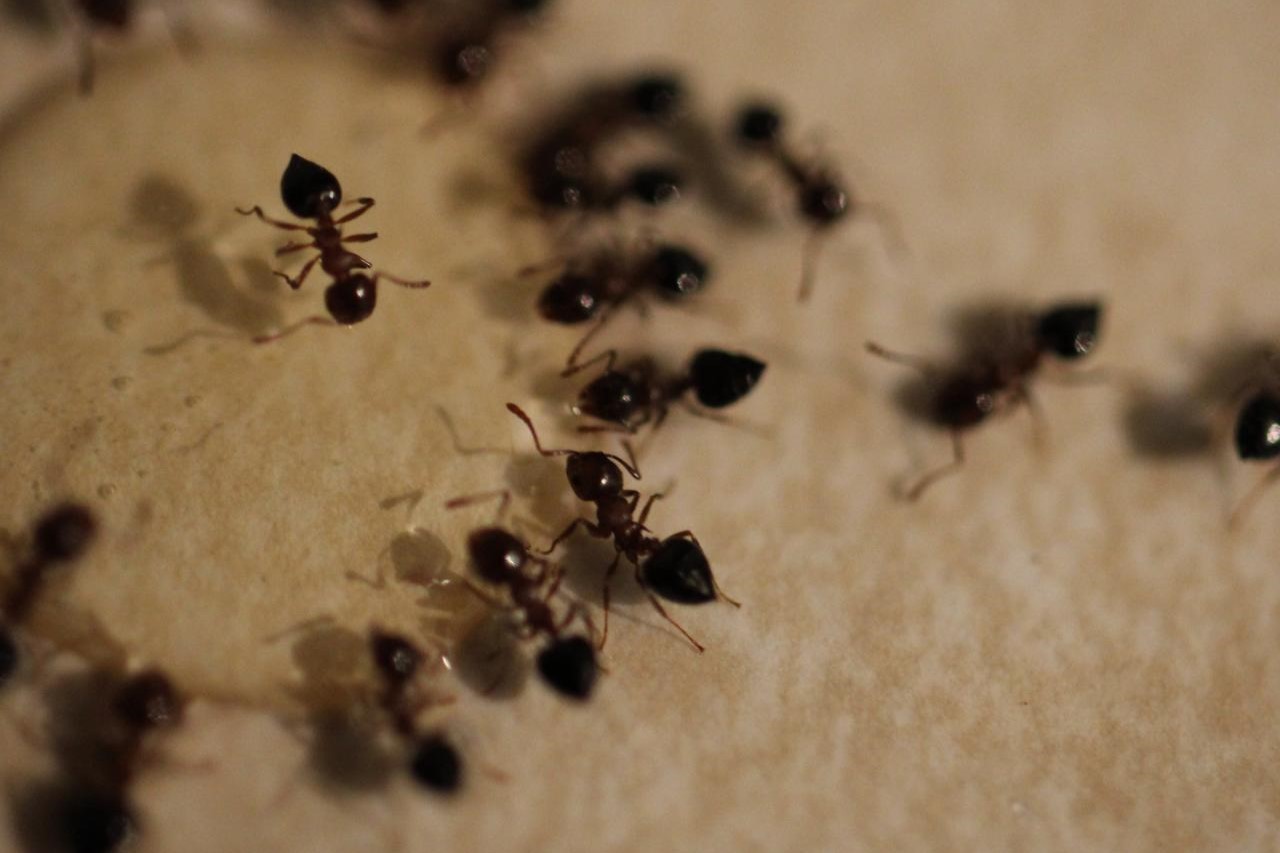Home>Home and Garden>The Ultimate Guide To Killing Ants And Treating Your Yard Without Mounds


Home and Garden
The Ultimate Guide To Killing Ants And Treating Your Yard Without Mounds
Published: February 8, 2024
Discover effective methods for eliminating ants and maintaining a pristine yard without unsightly mounds. Enhance your home and garden with our comprehensive guide.
(Many of the links in this article redirect to a specific reviewed product. Your purchase of these products through affiliate links helps to generate commission for Noodls.com, at no extra cost. Learn more)
Table of Contents
Understanding Ant Behavior
Ants are fascinating creatures with complex social structures and behaviors. Understanding their behavior is crucial in effectively managing and controlling ant infestations in your yard. These tiny insects operate as highly organized colonies, each with specific roles and responsibilities. By delving into the intricacies of ant behavior, you can gain valuable insights into how to combat their presence in your home and garden.
Social Structure: Ants live in colonies, which can range from a few dozen to several thousand individuals, depending on the species. Each colony is comprised of a queen, male ants, and worker ants. The queen's primary role is to reproduce, while the male ants' sole purpose is to mate with the queen. Worker ants, on the other hand, are responsible for foraging, caring for the young, and defending the colony.
Communication: Ants communicate with one another using a variety of methods, including chemical signals, touch, and sound. They release pheromones to mark trails, food sources, and even to signal danger. This sophisticated communication system allows ants to coordinate their activities and respond rapidly to changes in their environment.
Foraging Behavior: Ants are relentless foragers, constantly seeking sources of food to sustain the colony. They are attracted to a wide range of food types, including sugary substances, proteins, and fats. Once a food source is located, worker ants transport it back to the colony, following pheromone trails to guide them.
Nesting Habits: Ants build nests in a variety of locations, including soil, wood, and even within the walls of buildings. The location and structure of the nest depend on the ant species. Understanding the nesting habits of the specific ant species in your yard is essential for effective control and management.
By gaining a deeper understanding of ant behavior, you can implement targeted strategies to disrupt their activities and prevent infestations. This knowledge will empower you to take proactive measures to protect your yard and home from these industrious insects.
Identifying Ant Species in Your Yard
Identifying the specific ant species present in your yard is a crucial step in effectively managing ant infestations. Different ant species exhibit varying behaviors, nesting habits, and food preferences, making accurate identification essential for targeted control measures. Here are some common ant species you may encounter in your yard:
-
Carpenter Ants: These large ants, typically black in color, are known for excavating wood to build their nests. They prefer moist or decaying wood, making them a potential threat to wooden structures in your yard. Spotting sawdust-like debris near wooden elements or hearing rustling sounds within walls may indicate a carpenter ant infestation.
-
Odorous House Ants: These small, dark brown ants emit a distinctive, unpleasant odor when crushed, resembling the scent of rotten coconuts. They are often found foraging for sweets and can establish colonies in diverse locations, including wall voids and under floors.
-
Fire Ants: Recognizable by their reddish-brown color and aggressive nature, fire ants construct large, dome-shaped mounds in open areas of your yard. Their stings can cause painful welts and allergic reactions in some individuals, posing a significant threat to both humans and pets.
-
Pharaoh Ants: These tiny yellow or light brown ants are notorious for establishing extensive colonies within buildings. Their ability to thrive in diverse environments and rapidly reproduce makes them challenging to eradicate once established.
-
Argentine Ants: Often forming massive supercolonies, Argentine ants are light to dark brown in color and are attracted to sweet foods. They are highly adaptable and can quickly overrun a yard, displacing native ant species in the process.
To accurately identify the ant species in your yard, observe their physical characteristics, foraging patterns, nesting sites, and any distinctive behaviors. Additionally, seeking professional assistance from entomologists or pest control experts can provide valuable insights into the specific ant species present and the most effective control methods.
Understanding the ant species inhabiting your yard enables you to tailor your approach to ant management, ensuring that your efforts are precise and targeted. Armed with this knowledge, you can implement strategies to address the unique challenges posed by each ant species, effectively minimizing their impact on your yard and home.
Natural Ways to Kill Ants
When facing an ant infestation in your yard, natural methods offer effective and environmentally friendly solutions to control these persistent pests. Here are several natural approaches to eliminate ants and deter them from invading your outdoor space:
1. Diatomaceous Earth
Diatomaceous earth, a fine powder derived from fossilized algae, is a potent natural insecticide. When ants come into contact with diatomaceous earth, the powder dehydrates their exoskeletons, ultimately leading to their demise. To utilize this method, simply sprinkle diatomaceous earth along ant trails, near entry points, and around potential nesting sites.
2. Vinegar
The strong scent of vinegar disrupts the pheromone trails that ants use for navigation, effectively deterring their movement. Create a solution of equal parts water and vinegar, then spray it directly onto areas where ants are prevalent. Additionally, wiping down surfaces with this solution can erase existing scent trails, impeding ants from foraging in those areas.
3. Essential Oils
Certain essential oils, such as peppermint, tea tree, and citrus oils, possess natural insect-repelling properties. Dilute these oils with water and spray the solution around entryways, windows, and other ant access points. The potent aroma of these oils serves as a natural deterrent, discouraging ants from venturing into your yard.
4. Boiling Water
For ant mounds located in your yard, pouring boiling water directly into the nest can effectively eradicate the colony. This method is particularly useful for addressing fire ant mounds and can significantly reduce their population without resorting to chemical interventions.
5. Natural Ant Baits
Homemade ant baits can be crafted using a mixture of sugar, borax, and water. The sugar attracts the ants, while the borax acts as a slow-acting poison. Place these baits in areas frequented by ants, ensuring they are out of reach of children and pets. As the ants consume the bait and transport it back to the colony, the borax effectively eliminates the entire ant population.
By incorporating these natural approaches into your ant control strategy, you can effectively manage ant infestations in your yard while minimizing the impact on the environment. These methods offer a safe and sustainable means of combating ants, providing you with peace of mind and a pest-free outdoor environment.
Chemical Treatments for Ants
When natural methods prove insufficient in controlling ant infestations, chemical treatments can offer effective solutions for managing these persistent pests. It is important to approach chemical treatments with caution, ensuring that they are applied safely and in accordance with product instructions. Here are several commonly used chemical treatments for ants:
Read more: How To Get Rid Of Ants In Yard
1. Ant Bait Stations
Ant bait stations are designed to attract ants with a combination of attractive bait and insecticidal substances. The ants are lured to the bait, consume the toxic substance, and then carry it back to the colony, effectively eliminating the entire population. This method targets the source of the infestation, making it a strategic and efficient approach to ant control.
2. Insecticidal Sprays
Insecticidal sprays formulated specifically for ant control can be applied directly to ant trails, entry points, and nesting sites. These sprays contain potent insecticides that quickly eradicate ants upon contact. It is important to use these sprays judiciously, minimizing their impact on non-target organisms and the environment.
3. Dust Insecticides
Dust insecticides are finely powdered formulations that can be applied to areas where ants are active, such as cracks, crevices, and voids. When ants come into contact with the dust, it adheres to their bodies, effectively delivering the insecticidal substance as they groom themselves and interact with other colony members. Dust insecticides provide long-lasting control and are particularly effective in hard-to-reach areas.
4. Granular Insecticides
Granular insecticides are designed to be spread over outdoor areas where ants forage, such as lawns, gardens, and perimeter spaces. These granules release insecticidal compounds that target ants upon contact, effectively reducing their population and preventing further infestations. Granular insecticides offer a convenient and targeted approach to ant control in outdoor environments.
5. Professional Pest Control Services
In cases of severe or persistent ant infestations, seeking the expertise of professional pest control services may be necessary. Pest control professionals can assess the extent of the infestation, identify the ant species involved, and implement targeted chemical treatments to eradicate the pests. Additionally, they can provide guidance on preventive measures to minimize future infestations.
When utilizing chemical treatments for ant control, it is essential to prioritize safety and environmental responsibility. Always follow product instructions, use protective equipment when applying chemical treatments, and consider the potential impact on non-target organisms. By approaching chemical treatments with care and responsibility, you can effectively manage ant infestations while minimizing adverse effects on the surrounding ecosystem.
Preventing Ant Infestations in Your Yard
Preventing ant infestations in your yard requires a proactive and multifaceted approach aimed at disrupting ant access, eliminating attractants, and fortifying your outdoor space against potential incursions. By implementing preventive measures, you can create an inhospitable environment for ants, reducing the likelihood of infestations and minimizing the need for reactive control methods.
1. Seal Entry Points
Thoroughly inspect the exterior of your home and yard for potential entry points that ants could exploit. Seal cracks, gaps, and crevices in foundations, walls, and windows using caulk or other suitable sealants. By fortifying these entry points, you can prevent ants from infiltrating your living spaces and establishing nests in close proximity.
2. Maintain Cleanliness
Regularly clean outdoor dining areas, patios, and decks to remove food particles and spills that may attract ants. Keep garbage bins tightly sealed and promptly dispose of food waste to minimize potential food sources for foraging ants. Additionally, trim vegetation and remove debris from your yard to eliminate potential nesting sites and harborage areas.
3. Landscaping Considerations
Strategic landscaping can contribute to ant prevention efforts. Create a barrier of gravel or stone between your home's foundation and landscaping elements to deter ant movement. Consider planting ant-repelling vegetation, such as mint, lavender, or tansy, near entryways and outdoor living spaces to naturally deter ants from venturing close to your home.
4. Ant-Proofing Outdoor Structures
Apply weather-resistant sealants to wooden structures and furniture in your yard to prevent moisture accumulation, which can attract moisture-seeking ants. Consider using ant-proof barriers, such as adhesive tapes or specialized coatings, to protect trees, shrubs, and other outdoor structures from ant infestations.
5. Regular Inspections
Conduct routine inspections of your yard and outdoor structures to identify early signs of ant activity. By promptly addressing any indications of ant presence, such as trails, mounds, or nesting sites, you can prevent infestations from gaining a foothold and minimize the need for extensive control measures.
By integrating these preventive strategies into your yard maintenance routine, you can create an environment that is less conducive to ant infestations. Proactive ant prevention not only safeguards your outdoor living spaces but also contributes to a harmonious and pest-free yard environment for you and your family to enjoy.











